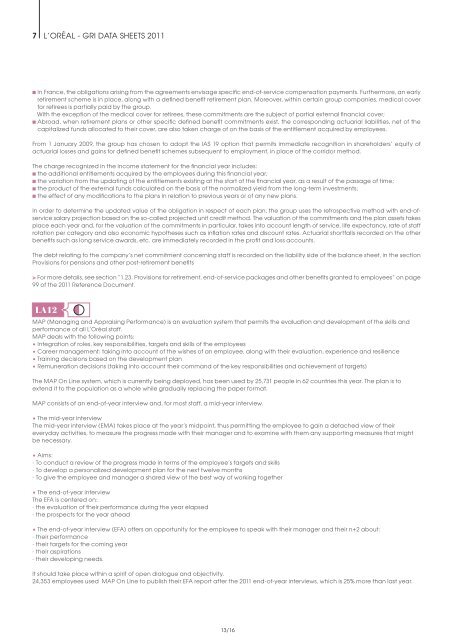Organizational Strategy - Sustainable Development - L'Oréal
Organizational Strategy - Sustainable Development - L'Oréal
Organizational Strategy - Sustainable Development - L'Oréal
You also want an ePaper? Increase the reach of your titles
YUMPU automatically turns print PDFs into web optimized ePapers that Google loves.
7 L’OréaL - GrI DaTa SHEETS 2011<br />
n In France, the obligations arising from the agreements envisage specific end-of-service compensation payments. Furthermore, an early<br />
retirement scheme is in place, along with a defined benefit retirement plan. Moreover, within certain group companies, medical cover<br />
for retirees is partially paid by the group.<br />
With the exception of the medical cover for retirees, these commitments are the subject of partial external financial cover;<br />
n abroad, when retirement plans or other specific defined benefit commitments exist, the corresponding actuarial liabilities, net of the<br />
capitalized funds allocated to their cover, are also taken charge of on the basis of the entitlement acquired by employees.<br />
From 1 January 2009, the group has chosen to adopt the IaS 19 option that permits immediate recognition in shareholders’ equity of<br />
actuarial losses and gains for defined benefit schemes subsequent to employment, in place of the corridor method.<br />
The charge recognized in the income statement for the financial year includes:<br />
n the additional entitlements acquired by the employees during this financial year;<br />
n the variation from the updating of the entitlements existing at the start of the financial year, as a result of the passage of time;<br />
n the product of the external funds calculated on the basis of the normalized yield from the long-term investments;<br />
n the effect of any modifications to the plans in relation to previous years or of any new plans.<br />
In order to determine the updated value of the obligation in respect of each plan, the group uses the retrospective method with end-ofservice<br />
salary projection based on the so-called projected unit credit method. The valuation of the commitments and the plan assets takes<br />
place each year and, for the valuation of the commitments in particular, takes into account length of service, life expectancy, rate of staff<br />
rotation per category and also economic hypotheses such as inflation rates and discount rates. actuarial shortfalls recorded on the other<br />
benefits such as long service awards, etc. are immediately recorded in the profit and loss accounts.<br />
The debt relating to the company’s net commitment concerning staff is recorded on the liability side of the balance sheet, in the section<br />
Provisions for pensions and other post-retirement benefits<br />
> For more details, see section “1.23. Provisions for retirement, end-of-service packages and other benefits granted to employees” on page<br />
99 of the 2011 reference Document.<br />
LA12<br />
MaP (Managing and appraising Performance) is an evaluation system that permits the evaluation and development of the skills and<br />
performance of all L’Oréal staff.<br />
MaP deals with the following points:<br />
• Integration of roles, key responsibilities, targets and skills of the employees<br />
• Career management: taking into account of the wishes of an employee, along with their evaluation, experience and resilience<br />
• Training decisions based on the development plan<br />
• remuneration decisions (taking into account their command of the key responsibilities and achievement of targets)<br />
The MaP On Line system, which is currently being deployed, has been used by 25,731 people in 62 countries this year. The plan is to<br />
extend it to the population as a whole while gradually replacing the paper format.<br />
MaP consists of an end-of-year interview and, for most staff, a mid-year interview.<br />
• The mid-year interview<br />
The mid-year interview (EMa) takes place at the year’s midpoint, thus permitting the employee to gain a detached view of their<br />
everyday activities, to measure the progress made with their manager and to examine with them any supporting measures that might<br />
be necessary.<br />
• aims:<br />
- To conduct a review of the progress made in terms of the employee’s targets and skills<br />
- To develop a personalized development plan for the next twelve months<br />
- To give the employee and manager a shared view of the best way of working together<br />
• The end-of-year interview<br />
The EFa is centered on:<br />
- the evaluation of their performance during the year elapsed<br />
- the prospects for the year ahead<br />
• The end-of-year interview (EFa) offers an opportunity for the employee to speak with their manager and their n+2 about:<br />
- their performance<br />
- their targets for the coming year<br />
- their aspirations<br />
- their developing needs.<br />
It should take place within a spirit of open dialogue and objectivity.<br />
24,353 employees used MaP On Line to publish their EFa report after the 2011 end-of-year interviews, which is 25% more than last year.<br />
13/16






